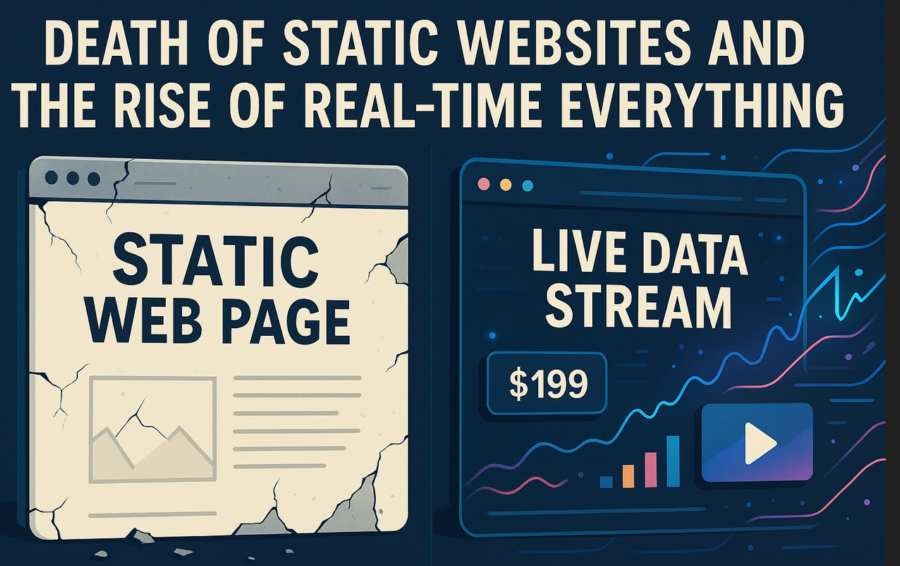The Death of Static Websites and the Rise of Real-Time Everything
 Static websites used to be the dependable uncle who wore the same shirt to every family gathering. Reliable, but a little too comfortable with irrelevance. Fast forward to 2025, and even that uncle has a holographic smartwatch syncing live barbecue data straight from the grill. Static pages? They're practically flipping the burgers of the past.
Static websites used to be the dependable uncle who wore the same shirt to every family gathering. Reliable, but a little too comfortable with irrelevance. Fast forward to 2025, and even that uncle has a holographic smartwatch syncing live barbecue data straight from the grill. Static pages? They're practically flipping the burgers of the past.
Itís no longer enough for a website to sit there, frozen like a deer in headlights. Users expect information that breathes ó not a wax museum exhibit. Real-time updates, live product availability, dynamic content personalization: these arenít fancy extras anymore. Theyíre the baseline expectations for a modern web presence. Moreover, companies like Rivo Agency raise the expectation bar higher every year.
Why Static Content No Longer Cuts It
When people land on a website today, they assume it knows who they are, what they want, and how they like their coffee. If your site loads a dusty page from three weeks ago, users bounce faster than a cat spotting a cucumber.
Markets change hourly. Product inventories fluctuate. Events unfold while your page is still pretending everythingís fine. Static content makes you look asleep at the wheel ó and users donít trust drivers who nap mid-traffic.
Beyond perception, thereís function. Search engines in 2025 increasingly prioritize fresh, real-time content in rankings. A static page might as well send itself a "Missing Persons" report.
The Power of Live Data Streams
Dynamic elements are no longer reserved for financial news tickers and airline updates. Now, even your neighborhood bakery needs real-time data streaming ó to show which croissants are still warm enough to justify your poor life choices.
Smart personalization kicks it up another notch. Websites adapt based on user behavior, location, time of day, weather ó practically everything short of your blood pressure (although thatís probably coming by 2027).
Hereís what live data streams bring to even the humblest sites:
- Real-time inventory updates ó because ďOut of StockĒ is the digital equivalent of a broken promise.
- Dynamic pricing ó for those who enjoy playing roulette with their wallets.
- Personalized recommendations ó offering you things you didnít know you desperately needed at 3 AM.
- Live event updates ó so no one shows up at your "sold-out" goat yoga class still wearing a hopeful smile.
Common Pitfalls That Turn Live Sites Into Crawling Nightmares
Before visions of glorious, living websites fill your mind, a reality check: badly implemented dynamic elements can make your site slower than a dial-up connection on a rainy day.
Heavy scripts, unoptimized APIs, and lazy polling methods bloat the experience until even your server starts passive-aggressively sighing at you. The irony? Chasing "real-time" can end up creating experiences that feel stuck in slow motion.
Architecting Live Without Killing Speed
If you want your website to dance in real-time without collapsing like a toddler in a ballet class, youíll need to build smart.
First, embrace edge computing and CDNs that can handle live data without sending every request back to the mothership. Edge functions allow you to process user-specific content closer to where they actually are, cutting down on loading lag.
Next, adopt frameworks designed for partial hydration ó like Astro, Qwik, or the latest iterations of Next.js. These allow critical content to load immediately, while sprinkling in dynamic elements after the fact. Think of it as serving the main course before bothering with the garnish.
Use WebSockets or Server-Sent Events (SSE) when appropriate, especially for true real-time needs like stock tickers, chat apps, or live sports scores. Avoid setting up a bazooka (read: constant heavy polling) when all you needed was a doorbell.
And finally, cache aggressively. Itís not cheating. It's strategic laziness. Cache static assets where possible, cache API responses smartly, and make sure you don't force users to reload 400 scripts to find out that, yes, the avocado toast is still $12.95.
Knowing When to Chill
Not every single element needs to update live. Showing a customer that there are now two fewer sweaters available in blue since their last page load isnít likely to inspire awe ó just confusion. Real-time should enhance the experience, not make it feel like you're being followed around a digital store by an overeager salesperson.
Pick your battles. Focus on areas where live data genuinely helps: product availability, time-sensitive content, user interactions, and personalization. Everything else can refresh the next time they blink.
Streaming Into the Sunset
Static websites had a good run. They gave us simple brochure pages, charmingly outdated restaurant menus, and countless "Under Construction" GIFs. But in 2025, a static site looks less like a solid foundation and more like a faded Polaroid taped to a moving bullet train.
Building with live data streams doesnít just future-proof your website. It creates something that's actually alive ó adapting, responding, growing. Just make sure itís fast, make sure itís intentional, and for everyone's sake, make sure itís not still trying to sell last monthís goat yoga tickets.
|
|


 Static websites used to be the dependable uncle who wore the same shirt to every family gathering. Reliable, but a little too comfortable with irrelevance. Fast forward to 2025, and even that uncle has a holographic smartwatch syncing live barbecue data straight from the grill. Static pages? They're practically flipping the burgers of the past.
Static websites used to be the dependable uncle who wore the same shirt to every family gathering. Reliable, but a little too comfortable with irrelevance. Fast forward to 2025, and even that uncle has a holographic smartwatch syncing live barbecue data straight from the grill. Static pages? They're practically flipping the burgers of the past.